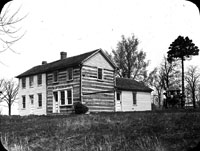The Policy of Polygamy

When did Joseph Smith abandon the policy of polygamy? How did he rationalize this shift in church policy?
Joseph Smith never abandoned the practice of polygamy; however, in the February 1, 1844 issue of the Latter-day Saints newspaper Times and Seasons, Smith and his brother Hyrum, co-presidents of the church, did publish a notice stipulating that Hiram Brown, a church elder in Michigan, had been cut off from the church for "preaching Polygamy, and other false and corrupt doctrines."
The renowned scholar Richard L. Bushman, who identifies himself as a "believing historian," asserts that rather than indicating a shift in church policy, the February 1844 edict comported with Smith's sermons and public statements of the period. On the pulpit, Smith vigorously denounced "adultery fornication" and polygamy, while in private, he revealed to trustworthy individuals and small groups within the church a revelation he had experienced that served to encourage and sanctify plural marriages that had been commanded by God, drawing on Old Testament practices as precedents. Smith ritualized the practice of polygamy through the institution of "sealing" couples together by priests of the church for eternity, thus allowing them to procreate eternally and achieve celestial glory. Smith denounced as adulterous polygamous practices that had not been sanctified by the church. Bushman concedes, "The distinction between priesthood calls to take additional wives and unlicensed indulgence was clear to him [Smith] if not always to others."
John C. Bennett, the co-founder with Smith of the Latter-day Saint town of Nauvoo, Illinois, and its first mayor, had been excommunicated two years earlier after telling numerous women in the community "that illicit sexual intercourse was acceptable if kept secret," according to Bushman. The February 1844 edict implied an attempt to disassociate the church from such rogue missionaries as Bennett and Brown, especially during a period in which Smith had become a candidate for the presidency of the United States. The church doctrine of sanctified plural marriages was not acknowledged publicly until 1852, eight years after Smith's assassination. In 1890, due to pressure from the federal government, the church issued a manifesto announcing that it no longer sanctioned plural marriages. Subsequent edicts in 1904 and 1910 threatened excommunication to church members and priests who entered into or performed new plural marriages.
Richard L. Bushman, with the assistance of Jed Woodworth, Joseph Smith: Rough Stone Rolling. New York: Knopf, 2005.
Donna Hill, Joseph Smith, The First Mormon. Salt Lake City, Utah: Signature Books, 1977.
Kathryn M. Daynes, More Wives Than One: Transformation of the Mormon Marriage System, 18401910. Urbana, Ill. and Chicago: University of Illinois Press, 2001.